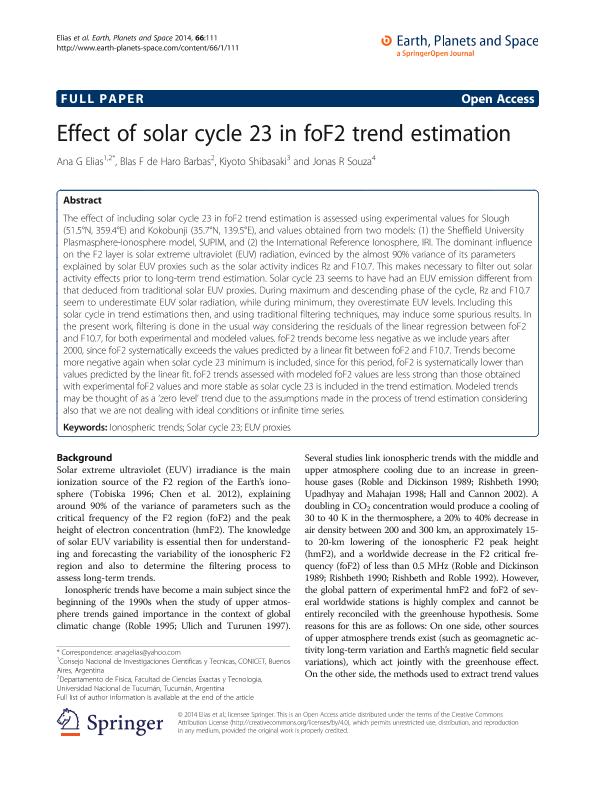Artículo
Effect of solar cycle 23 in foF2 trend estimation
Fecha de publicación:
09/2014
Editorial:
Springer
Revista:
Earth Planets And Space
e-ISSN:
1880-5981
Idioma:
Inglés
Tipo de recurso:
Artículo publicado
Clasificación temática:
Resumen
The effect of including solar cycle 23 in foF2 trend estimation is assessed using experimental values for Slough (51.5°N, 359.4°E) and Kokobunji (35.7°N, 139.5°E), and values obtained from two models: (1) the Sheffield University Plasmasphere-Ionosphere model, SUPIM, and (2) the International Reference Ionosphere, IRI. The dominant influence on the F2 layer is solar extreme ultraviolet (EUV) radiation, evinced by the almost 90% variance of its parameters explained by solar EUV proxies such as the solar activity indices Rz and F10.7. This makes necessary to filter out solar activity effects prior to long-term trend estimation. Solar cycle 23 seems to have had an EUV emission different from that deduced from traditional solar EUV proxies. During maximum and descending phase of the cycle, Rz and F10.7 seem to underestimate EUV solar radiation, while during minimum, they overestimate EUV levels. Including this solar cycle in trend estimations then, and using traditional filtering techniques, may induce some spurious results. In the present work, filtering is done in the usual way considering the residuals of the linear regression between foF2 and F10.7, for both experimental and modeled values. foF2 trends become less negative as we include years after 2000, since foF2 systematically exceeds the values predicted by a linear fit between foF2 and F10.7. Trends become more negative again when solar cycle 23 minimum is included, since for this period, foF2 is systematically lower than values predicted by the linear fit. foF2 trends assessed with modeled foF2 values are less strong than those obtained with experimental foF2 values and more stable as solar cycle 23 is included in the trend estimation. Modeled trends may be thought of as a ‘zero level’ trend due to the assumptions made in the process of trend estimation considering also that we are not dealing with ideal conditions or infinite time series.
Palabras clave:
Ionospheric Trends
,
Solar Cycle 23
,
Euv Proxies
Archivos asociados
Licencia
Identificadores
Colecciones
Articulos(CCT - NOA SUR)
Articulos de CTRO.CIENTIFICO TECNOL.CONICET - NOA SUR
Articulos de CTRO.CIENTIFICO TECNOL.CONICET - NOA SUR
Citación
Elias, Ana Georgina; de Haro Barbás, Blas F.; Shibasaki, Kiyoto ; Souza, Jonas R.; Effect of solar cycle 23 in foF2 trend estimation; Springer; Earth Planets And Space; 66; 111; 9-2014; 1-5
Compartir
Altmétricas




